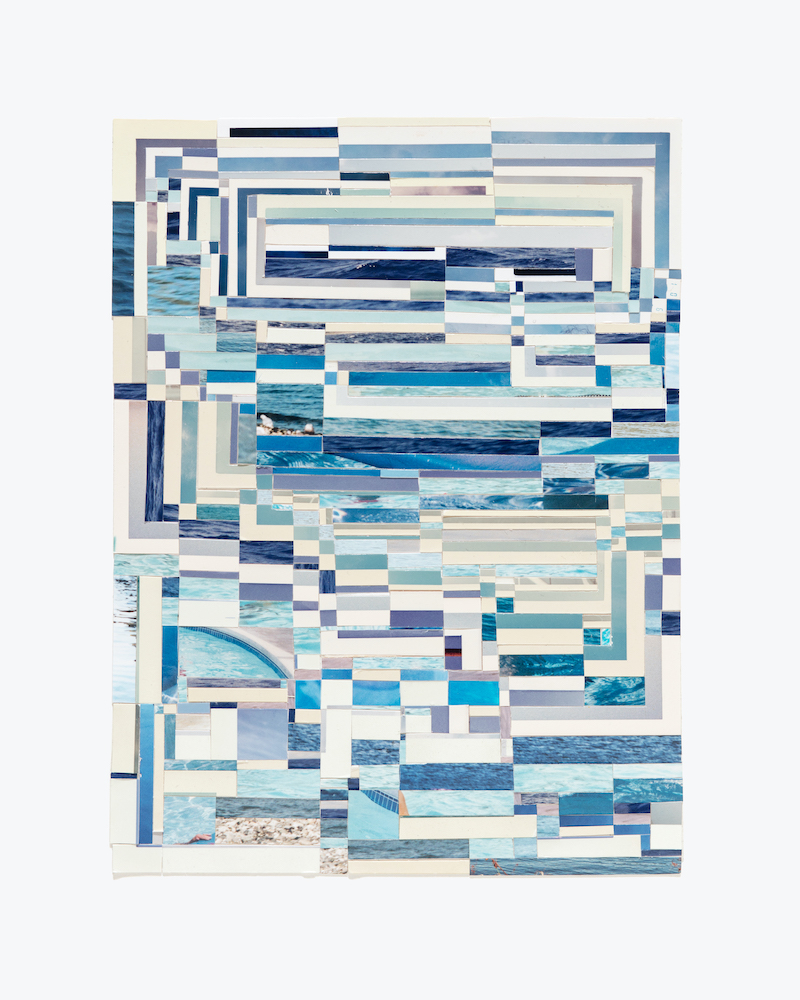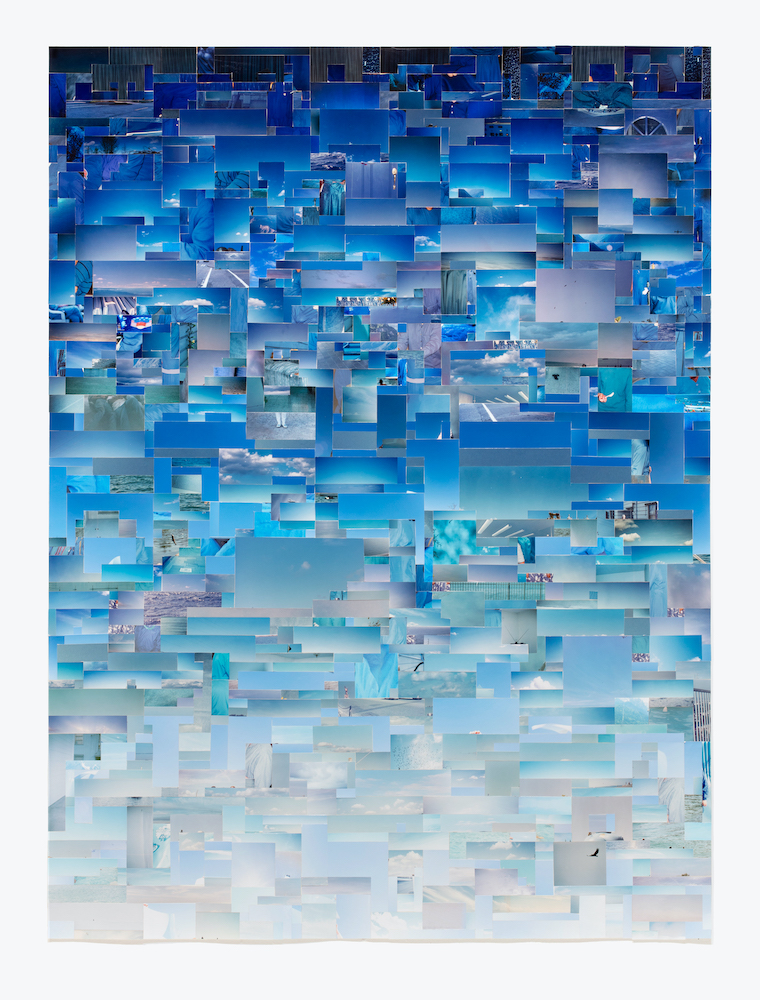Joe Rudko: Untitled Colors at the Von Lintel Gallery

©Joe Rudko, Orange, from Untitled Colors, Found photographs on paper, 50.5 x 38.12 inches, Unique Courtesy of the Von Lintel Gallery
Today, artist Joe Rudko opens the exhibition, Untitled Colors, at the Von Lintel Gallery in Santa Monica, running through December 2021. Rudko has a legacy of creating new ways of seeing by merging of photographic materials, more specifically vernacular images that are reimagined into unique artforms. Not dissimilar to mid century paintings, but rather than brush strokes, Rudko uses scraps of visual memories to build a canvas of color, shape, and information. The exhibition, Untitled Colors, is based on 10 large single-color photographic works.
For United Colors, gallerist Tarrah Von Lintel shares that the artist has “collected thousands of personal snapshots from friends, family, and anonymous internet vendors before deconstructing and intricately arranging them into large vibrant color fields. These photomontages of vernacular analog photographs, evoke intimate memories and strong personal associations. Each work brings together diverse imagery from over a century of the printed image, while using color as the unifying principle. Although inherently photographic, they also become abstractions, with sharp details that root them in the world of representation, tying them to a specific time and place. Arranged within a structural grid, they are influenced by both Mesopotamian mosaics and the digital pixel. Rudko’s physical act of merging photographic materials, consisting of different surface qualities and tonalities, is a meditation on the interconnectedness of memory and the collective desire to document and share experiences. Taking in these thousands of spliced images is an all-encompassing experience for the viewer, offering an abundance of information that teases an expansiveness beyond each frame.”
An interview with the artist follows.

©Joe Rudko, Orange (Detail 2), from Untitled Colors, Found photographs on paper, 50.5 x 38.12 inches, Unique Courtesy of the Von Lintel Gallery
Joe Rudko lives and works in Seattle, WA. He received his BFA from Western Washington University and has exhibited in numerous solo and group exhibitions in Seattle, Portland, Denver, Mexico City, Los Angeles, and New York City, including shows at Greg Kucera Gallery (Seattle, WA), the Portland Art Museum, PDX Contemporary Art (Portland, OR), Von Lintel Gallery (Los Angeles, CA), and Davidson Contemporary (New York, NY), among others. He was the recipient of the Future List Award, the Anne Tucker & Clint Willour Young Photographers Endowment, the Facebook AIR Program, and the Vermont Studio Center Fellowship Award.
His work is in the collections of The Getty Museum, the Portland Art Museum, the Cleveland Clinic, Fidelity Investments, the City of Seattle, Museum of Fine Arts Houston, and featured on the cover of indie rock band Death Cab for Cutie’s album Kintsugi.
Rudko’s work has been featured and reviewed in ARTFORUM, Art in America, HAFNY, City Arts Magazine, Fukt Magazine for Contemporary Drawing, art ltd., Visual Art Source, The Stranger,Lenscratch, and The New York Times.

©Joe Rudko, Magenta Object 2021 Found photographs on paper on panel 14 x 11 x 1.5 inches (35.6 x 27.9 x 3.8 cm) Unique verso JR 21 37
Congratulations on the new work and exhibition! Can you talk a bit about your conceptual process? Do you come up with an idea and set to work, or do concepts evolve though the art making?
Thanks. Since 2013 my work has been largely based on collected pictures. A lot of the ideas come when I’m organizing the various piles, boxes, and bags of pictures that litter my studio. I might start to notice the repetition of a particular color or subject matter, and it will get me thinking about how they can be combined. Most of the images I work with have been discarded at some point, so in a sense, I feel like I’m recycling. There’s an attempt to make new meaning and purpose with someone else’s trash.
One thing that has continued to resurface in the work is the borrowing of language from painting, drawing, and sculpture. It helps me find new ways of looking at old objects- compiling them in a way to find personal meaning.

©Joe Rudko, B/W 2021 Found photographs on paper 50.25 x 38.25 inches (127.6 x 97.2 cm) Unique verso JR 21 26, Courtesy of Von Lintel Gallery

©Joe Rudko, B/W (detail), 2021 Found photographs on paper 50.25 x 38.25 inches (127.6 x 97.2 cm) Unique verso JR 21 26, Courtesy of Von Lintel Gallery

©Joe Rudko, B/W (detail 2), 2021 Found photographs on paper 50.25 x 38.25 inches (127.6 x 97.2 cm) Unique verso JR 21 26, Courtesy of Von Lintel Gallery
Can you talk about the new project, Untitled Colors–it feels so connected to color field or mid-century paintings.
I went into this show with an idea to make “large abstract color fields”. I thought it would be a fun contradiction to make something simple, open, and abstract with photographic materials which are so specific, concrete, and fixed in time. I used color as a unifying principle for each work. Focusing on a single color at a time gave me the freedom to combine any subject matter or time period in the same piece
And yes! I was thinking about Rothko, Frankenthaler, Morris Louis, etc- painters who made non-objective art that went against the established norms in painting at the time. As someone who has a background in photography, I’m interested in where the boundaries of traditional photography are. Stealing ideas from color field’s was a way to approach a photograph with the openness that painting allows.

©Joe Rudko, Black 2021 Found photographs on paper 50.25 x 38.25 inches (127.6 x 97.2 cm) Unique verso JR 21 27

©Joe Rudko, Black 2021 Found photographs on paper 50.25 x 38.25 inches (127.6 x 97.2 cm) Unique verso JR 21 27

©Joe Rudko, Black (detail 2) 2021 Found photographs on paper 50.25 x 38.25 inches (127.6 x 97.2 cm) Unique verso JR 21 27
I would love you to describe your studio…I can’t imagine how you keep it organized when using thousands of photographs.
Tall ceilings. A skylight. Two big tables for laying out scraps. A cart for moving the scraps around. Lots of plants.
I keep it generally tidy, but there are always little scraps of photographs that litter the floor. I have stacks of archival photo boxes with labels like “color scraps” and “b/w edges”. Some of those boxes are filled with smaller plastic bags with contents like left eyes, reflections, water, hair, clouds, etc. Many are leftover from previous pieces or from half-started ideas.
The way I organize constantly changes alongside the needs of the work. I don’t always remember where I’ve put something, or that I’ve started an idea, so it makes for moments of discovery in the studio when I stumble across something I’ve forgotten about.
Do you listen to music while you work or have any rituals in your practice?
More recently I’ve been doing a guided meditation as a way of resetting before beginning my work for the day.

©Joe Rudko, Blue Scrap 2021 Found photographs on paper 15 x 11.25″ (38.1 x 28.6 cm) Unique verso JR 21 38
How have you been able to source this amount of imagery?
The images come from all over; friends, family, eBay, or a local ephemera shop that I frequent. In this show, I even included a few photographs that I took when I was a teenager. I wanted the sources to come from as many places as possible.
How much time goes into one of your constructions?
The larger works in this show took a little less than a month to make.

©Joe Rudko, Blue 2021 Found photographs on paper 50.25 x 38.12 inches (127.6 x 96.8 cm) Unique verso JR 21 42

©Joe Rudko, Blue (Detail) 2021 Found photographs on paper 50.25 x 38.12 inches (127.6 x 96.8 cm) Unique verso JR 21 42

Joe Rudkol Blue (Detail 2) 2021 Found photographs on paper 50.25 x 38.12 inches (127.6 x 96.8 cm) Unique verso JR 21 42
When did you shift from taking photographs to making work with photographs and can you describe your photographic practice…what themes were you exploring?
At Western Washington University I worked as an editorial photographer for the campus weekly and did freelance gigs on the side to help pay for school. I took classes in drawing, painting, and photography- with photography always my focus. During my last year of school in 2012 I started to feel a little jaded about identifying solely as a photographer. It felt like an identity that was limiting rather than expansive. Thats when I started experimenting more with the medium. One of the last true photo projects I made was a small book called “Little Nothing” which was made entirely of photographs taken while I was wandering around my neighborhood and noticing things. Another book I made was called “Catalog” in which I collected garbage and photographed it in a studio on candy-colored backdrops.

©Joe Rudko, Gray 2021 Found photographs on paper 50.5 x 38 inches (128.3 x 96.5 cm) Unique verso JR 21 29

Joe Rudko, Gray (Detail) 2021 Found photographs on paper 50.5 x 38 inches (128.3 x 96.5 cm) Unique verso JR 21 29
What artists are currently inspiring you?
Richard Tinkler, Carmen Winant, Paolo Arao, Amy Sillman’s book Faux Pas

©Joe Rudko, Green 2021 Found photographs on paper 50.25 x 38.25 inches (127.6 x 97.2 cm) Unique verso

©Joe Rudko, Red 2021 Found photographs on paper 50.25 x 38.12 inches (127.6 x 96.8 cm) Unique verso JR 21 32

©Joe Rudko, Violet 2021 Found photographs on paper 50.25 x 38.25 inches (127.6 x 97.2 cm) Unique verso JR 21 33
Posts on Lenscratch may not be reproduced without the permission of the Lenscratch staff and the photographer.
Recommended
-
Ricardo Miguel Hernández: When the memory turns to dust and Beyond PainNovember 28th, 2025
-
Pamela Landau Connolly: Columbus DriveNovember 26th, 2025
-
KELIY ANDERSON-STALEY: Wilderness No longer at the Edge of ThingsNovember 19th, 2025
-
Jackie Mulder: Thought TrailsNovember 18th, 2025


























































